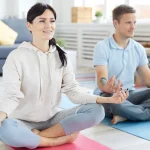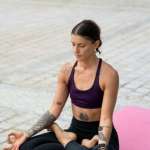Explore the details of hatha yoga to prepare the body and mind to stretch and meditate. Practice hatha yoga poses with asanas and breath to reach the goal of healing.
A Complete Guide of Hatha Yoga Poses
Do you feel any discomfort due to knee pain in your daily activities? Are you looking for yoga to practice at home to release the pain? Hatha yoga is best for you as a beginner in this case.
Hatha yoga combines yoga exercises and breath control practices to prepare the body for meditation and healing. It includes physical poses known as “Asana,” and the breathing system is called “Pranayama.” This yoga connects body and mind deeply with breathing to reduce muscle stress, joint pain, mental tension, and anxiety from the inside. It is excellent for enhancing well-being, a healthy life, and relaxation with mental peace.
This yoga has many postures, and different yoga styles allow you to practice basic to advanced physical yoga exercises. It is a slower practice and helps you to hold any pose for a long time. This feature makes it perfect for all levels of yogis. So, start your yoga session with Hatha postures to make your yoga class outstanding with this article. Let’s start-
Image source: istock
History of the Hatha Yoga
Hatha is one of the oldest formats of yoga, and it was designed many centuries ago. The word “Hatha” means “ ha” (sun) and “tha” (moon). This means “Hatha” relates to the assertive sense of physical exercise and the struggle to relieve inner evil thoughts.
Hatha yoga was tailored by Gorakhnath, the legendary founder of Kanphata yoga, in the 11th century. However, it became famous by Patanjali in the 2nd century BCE or 5th century CE. He described Hatha yoga in his popular Hindu classics yoga books “Yoga Sutra” and “Mahabhasya.”
Image source: istock
Hatha yoga is not only a form of yoga. It enclosed many designs of yoga for physical practice. So, you can define it as Vinyasa or Bikram yoga. Though, it is a combination of physical poses and breath work.
Types of Hatha Yoga Postures
I have already written that hatha yoga combines many yoga forms. So, it has many yoga methods. Some are suitable for beginners and some for sportspersons. Again, some are popular for long-aged yogis. There are fifteen primary hatha yoga postures according to the well-known hatha compilation “The Hatha Yoga Pradipika’. Seven postures demand seated practice, and eight sequences best suit non-seated yogis. Apart from this, Hatha yoga includes 84 yoga poses of Asanas. There is no specific pose for a particular demand. You can practice any pose or combine different poses according to your needs.
Image source: istock
How to Start Hatha Yoga Exercises?
Hatha yoga has no particular rules for starting your workout. You can choose any pose to go to your yoga session. But like any other yoga method, you must start your yoga journey by remembering the principles of yoga step by step. Read the section below to explore the application process of Hatha yoga-
Image source: istock
Step 1: Identify Your Need
First, clarify why you want to do hatha yoga poses. Choose beginner hatha yoga asanas pose if you want to do your habitual regular exercises with breath work. On the other hand, the advanced complicated hatha yoga sequences will best suit your professional career. Also, you can go with a combination of easy and advanced hatha yoga positions.
Step 2: Make A Plan
After identifying your needs, make a plan for how you will start. You must be admitted to a reputed yoga center for your profession. Take your physician’s advice when your goal is healing for chronic disorders. Then, go to online or offline yoga classes to select the perfect hatha yoga postures. Fix a time to do yoga daily.
Step 3: Gather Necessary Materials
Purchase necessary yoga materials, such as soft mats, clothes, shoes, gloves, and socks. You should wear cotton and loose clothes to feel comfortable while learning. Buy soft yoga mats to avoid injury or pain from the hard floor.
Step 4: Warm Up
Hatha yoga demands starting yoga learning with warm bodies like other yoga because yoga with a cold body can be harmful. To warm your body, do primary exercises such as running, jogging, and skipping. These exercises prepare your body to learn yoga by warming the muscles, ligaments, and connective tissues. Also, these warm-ups will spread the blood around the body and brain evenly.
Step 5: Start Yoga Session
After completing all the above steps, it’s time to start your yoga session. First, create a pose slowly with the warm-up. Make perfect body alignment to stretch the muscles and remove stress. Connect your body and mind accurately with breathing. Hatha yoga allows you to practice from easy methods to advanced formats. Finish your yoga classes with a warm body.
Why are Hatha Yoga Postures Important?
At present, people face different stress, anxiety, and mental pressure in their regular activities. Hatha yoga is excellent for releasing these problems. This yoga increases your health awareness, muscle strength, stamina, sleeping cycles, hormone stimulation, and digestion.
Besides this, hatha yoga reduces physical stress, muscle tension, joint pain, mental anxiety, irritation, and frustration. It allows you to make perfect body poses to stretch the body. Hatha yoga poses work by connecting yoga poses and deeper breath work. Proper breathing provides extra oxygen in the blood. So, your brain gets the necessary blood to activate the neurotic nerves.
Additionally, today, people practice hatha yoga for many reasons. It makes yoga classes enjoyable and attractive. Hatha yoga helps you struggle against your inner negativity. It transforms your limitations into possibilities. You can discover your inner calm and divinity with spiritual Hatha yoga exercises.
Apart from this, Hatha yoga poses enhance your mood and mental satisfaction. You can enjoy a healthy life and relaxation from the inside. For instance, you can reduce your anxiety prominently by doing Hatha yoga exercises in only 12 sessions.
15 Primary Hatha Yoga Poses
Hatha yoga is super flexible and versatile. It is excellent for beginners, long-aged yogis, sportspersons, women, and even kids. You can select the traditional or modern classic hatha yoga poses. Also, you can experiment with the blend of traditional and classic Hatha yoga poses. Here, I included 15 primary Hatha yoga poses. You can start to explore the experience-
- Swastikasana
- Gomukhasana
- Veerasana
- Kurmasana
- Kukkutasana
- Uttanakurmasana
- Dhanurasana
- Matsyendrasana
- Paschimottanasana
- Mayurasana
- Shavasana
- Siddhasana
- Padmasana
- Simhasana
- Bhadrasana
Hatha yoga poses encourage wellness, breathing, and mental peace. This yoga offers a wide variety of designs to stretch the whole body. Every pose works for specific organs, making it perfect for definite body parts. Regular hatha yoga practice promotes harmony of the body and mind by discovering inner purity and the essence of divinity. You can practice only hatha yoga or a combination of Vinyasa or Bikram yoga to refresh your body and mind.
FAQs
How many poses are there in Hatha yoga?
Hatha yoga has 84 yoga poses because it includes different types of yoga styles. This feature makes it famous and suitable for all levels of yoga disciples. It has beginner poses and complicated yoga poses.
What are the 15 asanas of hatha yoga?
Hatha yoga has 15 asanas, known as primary poses. Eight poses are designed for seated practice, and seven are for non-seated learning. These 15 asanas are-Swastikasana, Gomukhasana, Veerasana, Kurmasana, Kukkutasana, Uttanakurmasana, Dhanurasana, Matsyendrasana, Paschimottanasana, Mayurasana, Shavasana, Siddhasana, Padmasana, Simhasana, and Bhadrasana.
What are the 5 steps of hatha yoga?
Every yoga has some rules for learning. Hatha yoga is not different from them. This yoga has 5 steps to learn. They are-
- Kriyas — purification practices.
- Asanas — physical body exercises.
- Pranayama — exercises that regulate the breath.
- Bandhas — energetic locks.
- Mudras — hand gestures.
What is the difference between Hatha Yoga and regular yoga?
Regular yoga usually defines different types of yoga methods. This yoga is known as modern or classic yoga. It includes Vinyasa, Ashtanga, Power Yoga, or Bikram yoga. This yoga pose demands faster practice than Hatha yoga. It offers less time to hold a pose. Also, it focuses on increasing strength and stamina with power yoga poses.
On the other hand, Hatha yoga focuses on accurate body postures and deeper breathwork to prepare the body for healing and meditation. This yoga allows slower body movements and gentle breathing to get refreshes between body and mind. It encourages the balance of energy and activity.
What are the eight stages of Hatha yoga?
The eight stages of Hatha yoga are called the eight limbs of yoga. They are Yama (abstinences), Niyama (observances), Asana (yoga postures), Pranayama (breath control), Pratyahara (withdrawal of the senses), Dharana (concentration), Dhyana (meditation), and Samadhi (absorption).






